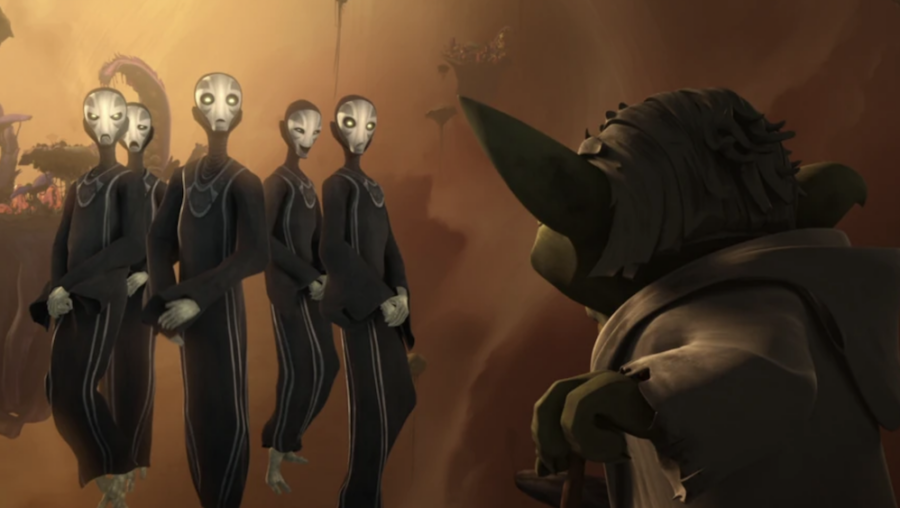The Midi-Chlorians Of Star Wars Explained

There were many controversial additions to the Star Wars canon when George Lucas released his first film of the prequel trilogy, The Phantom Menace. Other than Jar-Jar, perhaps one of the initial ideas that fans hated most where midi-chlorians, which essentially gave a scientific explanation for the Force. Now they’re a bit more accepted as part of the lore, but how do these microscopic life forms work?
Essentially, midi-chlorians are microscopic, intelligent life forms that are found within the cells of all living things in the Star Wars universe. These tiny lifeforms serve as the connection between the Living Force and the Cosmic Force. The Living Force and the Cosmic Force are two symbiotic aspects of the force, and together they bind all things in the galaxy.
Midi-chlorians are microscopic, intelligent life forms that are found within the cells of all living things in the Star Wars universe.
The Living Force came from the Cosmic Force, and midi-chlorians act as the bridge between the two, communicating the will of the Cosmic Force to living beings. Those who die return to the Cosmic Force to complete the cycle.

Those who have an especially high number of midi-chlorians in their blood are able to sense the will of the Force and utilize its energy. Thus you have Jedi, Sith, and other force-sensitive beings.
When Star Wars: Episode 1 – The Phantom Menace came out, we learned that the Jedi Order could take a blood sample to test the midi-chlorian count of force-sensitive individuals. This is how they learned that Anakin Skywalker had an especially high count in his blood, even more than Master Yoda. According to that film, his count was over 20,000.
Those who have an especially high number of midi-chlorians in their blood are able to sense the will of the Force and utilize its energy.
That film would further prove the midi-chlorians’ connection to the Cosmic Force when it was revealed that Anakin Skywalker didn’t have a biological father and that he was likely conceived by midi-chlorians, leading Qui-Gon Jinn to surmise that Anakin was the Chosen One prophesied to bring balance to the Force.
Around a decade after the Jedi Order discovered Anakin, Yoda would go on a journey where he found the Wellspring of Life, the birthplace of midi-chlorians at the center of the galaxy.

It was there where Yoda met beings known as the Force Priestesses, who embodied the midi-chlorians’ link between the Cosmic and Living Force. Following Yoda’s journey and subsequent trials on the Sith homeworld of Moraband, he would learn the secret to becoming one with the Force and manifesting his consciousness as a Force spirit after death. The Sith would attempt to use these beings for more nefarious purposes.
One of the ways that Sheev Palpatine was able to tempt Anakin to the Dark side was by telling him the tale of Darth Plageius, who he claimed manipulated midi-chlorians to create new life and achieve immortality.
In more recent Star Wars lore, we saw Doctor Pershing in The Mandalorian using Grogu’s blood for experimentation, due to his high midi-chlorian count. Presumably, these experiments played some part in cloning Palpatine and bringing him back from the dead.
George Lucas had come up the concept of midi-chlorians back in 1977, but the original trilogy didn’t incorporate them at all.
Interestingly, Lucasfilm has claimed that George Lucas had come up with this concept way back in 1977, though the original trilogy obviously didn’t incorporate them at all. When they were introduced to the canon in Star Wars: Episode 1 – The Phantom Menace, fans were not happy and felt that the overly scientific explanation for midi-chlorians took away some of the mystical and spiritual mystery of the Force.
There are plenty of fans still unhappy to this day with the concept, though the expanded lore that was shown in The Clone Wars (Yoda’s journey to the Wellspring of Life) did help to make the concept a little more palatable.
In any case, there are always going to be Star Wars fans that aren’t happy with every aspect of the franchise. Midi-chlorians is one of many concepts that will likely remain divisive from now until the end of time. But at least now you sort of maybe know how they work.












